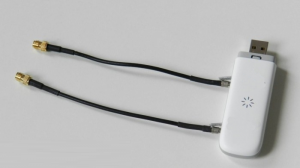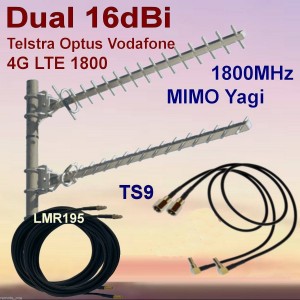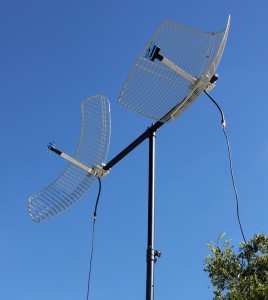What antenna do I need?
Selecting the Right Antenna
Before we begin it’s important to understand that you will need three pieces of equipment to improve your mobile signal:
- Antenna
- Cable
- Something to connect your cable to your phone/modem
Ok, so an antenna is the obvious one. But it’s often overlooked that your mobile phone or wireless broadband modem is connected to an antenna just like your TV is, and just like your TV, it’s antenna works best when installed on the outside of your car or house, and as high as possible. This means you’ll need some cable to cover the distance from where you want to put the antenna, to where you want to use your phone or modem.
You’ll then need something to connect your cable into your phone or modem. Modems are very easy – all good quality modems have an external antenna port, meaning all you need is a small adapter cable called a patch lead to go from the big connector on the cable to the tiny connector on your modem.
Let’s Get Started..
There’s three main factors that reduce your phone coverage:
- Distance from the cell tower
- Terrain (such as hills between you and the tower)
- Your house (blocking signal reaching indoors)
Distance
It’s no surprise mobile signal is reduced by distance (due to the Inverse-Square Law) from the cell tower, causing a gradual weakening of signal. In flat terrain, most cell towers have a usable range of about 40km before you’ll need to use an external antenna. With a good quality external antenna it’s possible to receive signal as far as 120km!
Terrain
Because of the diffracting nature of radio waves (bending over hills, around objects) it’s important to understand that being able to see a cell tower is not the ‘be all and end all’ of obtaining signal – if you’ve travelled through a hilly area you’ll no doubt have noticed you still have mobile reception despite being in a small dip or behind a rise in terrain. Large or sudden changes in terrain will however significantly impact phone coverage – in this type of scenario the important success factor is gaining height by raising an antenna into the air.
Building Penetration
Mobile signal is reduced when passing through buildings, trees, water, and even the air we breathe. The worst offenders are thick and conductive materials such as concrete, metals and foil-based insulation – this is often why signal can be weak indoors despite a strong signal outside.
Step 1 – What network am I on?
On the surface this seems like a simple question to answer and for some networks, like Telstra, it is. However what we really want to determine is what frequency the network operates on in your area. While there are countless mobile network operators, there are only three mobile networks operating in Australia – Telstra, Optus, and Vodafone.
Step 2 – Where am I?
Different antennas are designed for different situations. You’ll need to think about where you’re trying to improve service – the house? the car? Are you in one location or moving about? Rather than talking about antenna types and gains, this guide will work through the best antennas for houses, vehicles, and marine vessels.
The House or Office
The best place to start is often by performing a quick self check. Walk around the house – is there a particular spot where signal is good? Walk outside the house or on to the street – does signal improve? Climbing up on your roof can give you an idea whether height is an important factor in improving signal. The next important thing you can do is work out where the nearest Telstra tower is, and how many are in the area.
Indoor Antennas
If you’re on the move or don’t have the room to mount a cumbersome roof antenna, an indoor antenna is a convenient way to improve mobile phone service or wireless broadband speed. While the much smaller dBi gain reduces strength, it instead allows these antennas to receive from many directions – no need to fiddle about to find the optimal direction – perfect if you’re moving around or don’t know where the best cell tower is.
If you’ve noticed your signal strength is usually stronger next to a window or doorway then this is often the best place to put an antenna.
Roof Antennas
Most issues with slow wireless broadband or bad phone reception are solved with a roof mounted antenna. If you’ve located your nearest cell tower, the next step is a breeze.
There are two main types of roof antennas – omnidirectional (collinear) antennas, and directional (yagi) antennas. Omnidirectional antennas are designed for areas around town or in the suburbs where there are often several cell towers within range. This antenna leaves your mobile to decide which tower offers the best signal. However you’ll notice as they spread their power over a 360° range, they do not receive as strongly as their yagi counterparts.
Directional, or, Yagi antennas are the much more popular choice as their high power provides the strongest increase of all antenna types. The trade-off here is that they require aligning in the direction of the cell tower – the higher the dBi gain, the more precise you will have to be. In deciding between yagi models, the wider angle of the 12-14dBi antennas make them more suitable for hilly areas, with the 15-16dBi antennas more suited to very long range connections with less hills in the way.
There are typically 3 yagi antennas that we recommend for different areas depending on their terrain type and distance.
- 12dBi LPDA Yagi: Short Distance (1-15km) or Nearby Hills (1-5km)
- 14dBi or 15dBi Yagi: Moderate Distance (15-30km)
- 16dBi Yagi: Long Distance (30-70km) or Flat Areas (hills > 15km away)
Antenna Gain
You might be wondering why would anyone buy a 6dBi antenna when they can buy a 9dBi instead. While it is true that a 9dBi has a higher gain, a higher gain does not always result in better performance. Different antenna sizes and type have differing 3 dimensional patterns in which they receive signal. This is referred to as an antenna ‘radiation pattern’, and is often measured in terms of vertical and horizontal beamwidth.
Beamwidth refers to the angle in which an antenna receives signal, and is measured in degrees from the horizontal axis. Let’s suggest that in a perfect world all antennas receive the same amount of signal from the surrounding atmosphere in the shape of a doughnut, where width represents physical distance, and height represents physical height. Given that you’ve only got a certain amount of dough (signal) to make the doughnut with, you can either make your doughnut tall and skinny, or flat and wide (or perhaps somewhere in between). In terms of beamwidth, a tall doughnut has a larger vertical beamwidth, and a flat doughnut a small vertical beamwidth.
Different Types of Antenna
Aside from differing in gain, antennas also differ in their type of build. Each different build offers a different set of advantages and disadvantages.
Omnidirectional Antennas (Ground Independent)
These are the most common type of mobile phone/UHF/CB antenna and have a 360-degree horizontal beamwidth, meaning they work in all directions. This type of antenna does not require a ground plane to function, and hence it can be mounted with a small bracket on just about any surface and in any location. Best performance is achieved by mounting the antenna as high as possible – to eliminate as much signal interference as possible.
Magnetic Base Antennas (Ground Dependent)
A type of omnidirectional antenna that must be mounted onto a metal surface. Magnetic Base, or, Ground Dependent antennas are half the size of a ground independent designs by using the metal surface that they are connected to as the other half of the antenna. This means that the size, shape, and surface area of the metal object are very important in achieving the best possible result. This ground plane follows the same principles as the antenna – a larger surface allows for a larger fraction of the wavelength. Ideally a surface with a diameter greater than one wavelength (about 35cm for Telstra Next-G 850MHz) will perform best, smaller surfaces down to 9cm will produce acceptable results (quarter wave).
Magnetic base antennas also achieve a more compact design by incorporating one or more loading coils, which help to maintain resonance, improve the radiation pattern, and most of all make the antenna more flexible – very important for vehicles with low clearance.
Magnetic antennas are ideal for vehicles, but also make great indoor household antennas when mounted on filing cabinets and windowsills, and their compact design makes for an ideal travelling companion. While designed for metal surfaces, this type of antenna can be used on any other surface but will produce a gain 3dB less than what is stated – for example, a 7dBi magnetic antenna on a wood surface produces a 4dBi gain.
Yagi Antennas
That bizarre looking TV antenna on your roof is the most common example of a yagi antenna. With a much more powerful gain, it differs from the antennas discussed so far in the sense that it is a directional antenna. This means that to function effectively, it has to be pointed in the direction of the mobile phone tower. Yagi antennas trade their ability to work in all directions (omnidirectional), for an increased gain. This is achieved by putting an array of smaller ‘director elements’ in front of the actual connected element. These director elements receive incoming signal and re-radiate the signal, until it reaches the driven element (the one connected to the cable). Behind the driven element there is a slightly larger element known as a reflector, which simply does as its name suggests – reflects signal back to the driven element.
By increasing the number of director elements and length of the Yagi we reduce the horizontal and vertical beamwidth – resulting in an increased gain. For a 3dB (twice the power) increase in gain, we have to double the length of our Yagi. For these reasons often a Yagi will max out at 16dBi (on 850MHz) before becoming impractically long.
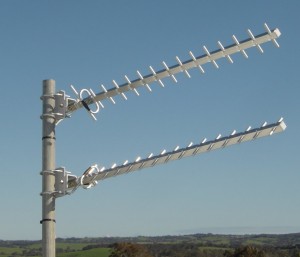
Dual 1800Mhz Yagi at 45 degrees angle (MIMO)
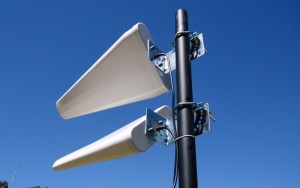
Dual LPDA (Logarithmic Periodic Dipole Antenna) Yagi at 45 degrees angle (MIMO)
MIMO (multiple-input and multiple-output) is a method for multiplying the capacity of a radio link using separate transmit and receive antennas to exploit multipath propagation.
Grid Parabolic Antennas
A Yagi increases it’s gain by increasing it’s length. Grid Parabolic antennas however increase their gain by increasing their width. This is sometimes preferable as they do not require stabilising brackets or cross bars. This type of antenna works in the same manner as a satellite dish – signal is reflected off the dish/grid and onto the small receiving element placed above the centre of the grid or dish.

